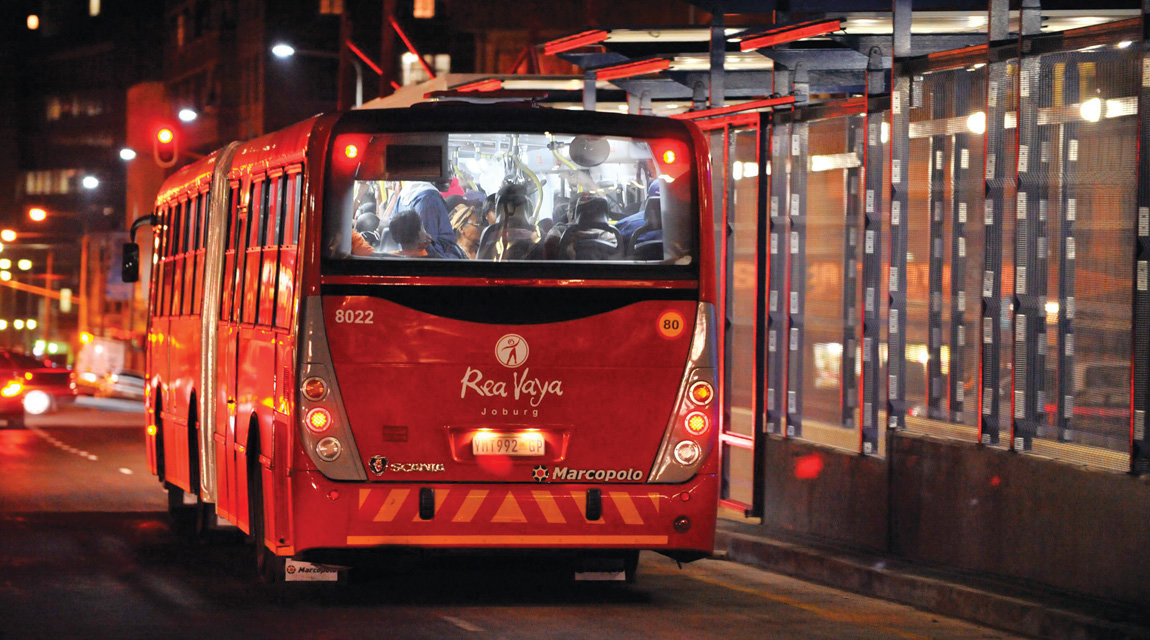Fighting for the survival of BRT

With the bus rapid transit (BRT) systems in South Africa still relying heavily on subsidies and transporting far fewer passengers than their international peers, MARISKA MORRIS takes a look at the planned future of BRT in South Africa.
Simply expanding highways and building roads will not be enough to keep up with the expected population growth for Johannesburg. Professor Jackie Walters, head of the University of Johannesburg’s Department of Transport and Supply Chain Management, notes that African cities are expected to grow by an additional 500-million people over the next 25 years.
Johannesburg is no exception. The population of Gauteng is expected to increase to 18,7-million people by 2037 from the current population of 11,2 million. The formal worker population is expected to be around 8,6 million in 2037, up from 3,8 million currently. The impact on the roads will be difficult to impossible to manage unless public transport becomes a main mode of transport for residents in these cities.
Why government turned to BRT
In the early 2000s, many Latin American cities implemented BRT services and reported subsidy-free transport services. These services made enough money through fares to cover operational costs. The promise of a subsidy-free transport service that could reduce the demand on roads was enough motivation to implement BRT locally.
However, most Latin American cities are very densely populated with more than seven-million residents, while in most cities in South Africa, particularly Johannesburg, the population is very spread out and commuters often have to travel long distances.
“On average, a BRT service has the potential to carry between 43 000 and 55 710 commuters per hour,” Walters points out. The Rea Vaya system in Johannesburg has about 5 760 passengers per hour, per direction, during peak hours. The BRT system in Istanbul, Turkey, has about 24 000 and the one in Bogota, Colombia, has 45 000.
The Rea Vaya service is also expensive to run. Operating costs for Istanbul are US$ 6 million (R80 million) per kilometre and Bogota spends about US$ 12,5 million (R167 million) per kilometre. South African cities, in comparison, spend in total about US$ 8,3 million (R110 million) per kilometre with not nearly the same return in passenger fares.
The deficit is covered by government subsidies – an unsustainable practice. In 2015, the MyCiTi bus service faced a R52-million deficit for Cape Town’s 2016/17 financial year, despite being one of the more successful implementations of a BRT service in South Africa. The MyCiTi service records on average around 75 000 passengers per typical weekday.
Professor Christo Venter and research associate Gary Hayes, from the Centre for Transport Development at the University of Pretoria, found that the total operational expenditure of BRT systems over six metros was R850,6 million of which R522,4 million came from subsidies.
Fare revenue per passenger (per trip) on the BRT systems in these metros is around R7,77, while the operational cost per passenger is R20,90. Subsidies make up the R12,84 deficit. The BRT services are more dependent on subsidies, but also have lower operating costs than other bus-based transport services. Conventional bus services cost R22 with a subsidy of R13,40 per passenger carried, while municipal buses cost R24,42 with a subsidy of R18,41.
Challenges for the South African BRT systems
The biggest obstacle for the South African BRT systems to overcome is the spatial layout of the cities. Dikeledi Magadzi, chairperson of the Portfolio Committee on Transport in parliament, notes: “The BRT systems face many historical challenges, including no development or spatial planning in the rural areas.”
South Africans who need public transport the most thus don’t have adequate access. Implementing and running BRT systems in these areas is costly and difficult.
“All the cities use too many consultants, which impacts heavily on finances. Negative perceptions of using buses compared to private vehicles among the public is also a challenge,” says Magadzi.
In addition, every BRT system faces its own unique challenges. In Johannesburg, for example, BRT buses carry 50 000 passengers a day, but many are non-paying passengers, who are able to board because of poor management of the fare-collection system. Magadzi notes: “With better technical management the Rea Vaya service can improve fare-paying ridership to 75 000 passengers a day.”
Tshwane, on the other hand, was overambitious. The BRT service was implemented and run before the major routes were completed. Magadzi says: “Tshwane should have waited to connect Soshanguve and Hammanskraal to the CBD and Menlyn.
“The integrated transport project is still new in South Africa, so it is understandable that it will experience highs and lows. Public transport is one of the challenges that impacts on the economy of the country. Efficient public transport will mean that the poor and working class will be better off with respect to saving time to travel and money.”
Future of BRT in Johannesburg and South Africa
Some of the benefits of the BRT system have been achieved, such as reduced congestion and environmental impact. However, to continue with the BRT services in South Africa, the system will have to be reworked. Venter and Hayes argue that cost should be a first priority. “Speed is the last consideration. Many people are not willing to pay for speed,” they say.
Reimagining the system will require considering a flexible approach that includes formal trunks and informal feeders. Venter and Hayes note: “There is a possible future for the BRT system, however, there needs to be a focus on service quality. A full BRT service can be retained on the few high-demand shorter routes with better integration of existing systems such as the minibus taxis.”
Jeff Ngcobo, executive head of Scheduled Services Management Agency, adds: “Our ten-year fundable plan will set out what modes of transport should be operating on what routes depending on two key issues – demand and current and future land use in the surrounding areas. We need to move people speedily to new areas with economic opportunity, such as Modderfontein.”
He adds that the integrated transport plan, on which the BRT systems in South Africa are based, will possibly also be revised. In the end, BRT services will be around for at least another decade or so, although the approach to the services needs to be addressed urgently and drastically revised to avoid the current unsustainable reliance on subsidies.
Along with better planning around BRT services, cities will need to rethink their spatial planning. To put it simply, Walters notes: “South African cities need to be densified to really support BRT systems.”
Published by
Mariska Morris
focusmagsa



